The native task manager has always been one of the main things I missed on the iPhone. The first iPhone suffered greatly from this absence, with the second generation it was solved by third-party applications. Nevertheless, I considered the task manager to be an application that almost every smartphone should have as a base. It took 4 years and finally we have it. We introduce you to Reminders.
Reminders is a very simple task manager that doesn't try to impress you with a list of features. It is a very simple intuitive tool whose task is to remind the user of anything. This rules it out as a usable GTD tool. After all, applications such as Things or OmniFocus count on more complex problem solving and their fulfillment, where the focus is project orientation. Reminders, however, can easily replace regular to-do lists or encourage those who until now wrote everything on paper to use them.
All tasks in Reminders are sorted into lists. You can have one general one where you write down all the tasks, or you can use several lists for example to determine the category (Personal, Work). Last but not least, you can use the lists, for example, for shopping, where you write in one list the things that you should not forget to put in the basket. A fixed item is also included Finished, where you can find all checked off tasks. Lists can evoke the aforementioned project orientation, where they can represent individual projects. However, without context tags and other options for linking tasks, the idea of GTD in Reminders falls apart.
While on the iPad there is a fixed panel with lists on the left where you switch between them, on the iPhone you switch between them by sliding your finger or calling up the menu at the top of the screen. Tasks can also be sorted by date, where you move from day to day in the newly opened calendar panel, and the tasks for the given day are displayed in the right part. On the iPhone, you have to call up the calendar with the button at the top, the list of tasks is then displayed in full screen and you move between individual days by sliding your finger or using the arrows at the bottom.
Entering tasks is very easy, just press the "+" button or click on the nearest free line and you can start writing. After pressing Enter, the cursor will automatically move to the next line, thanks to which you can enter several tasks at once in a very quick sequence, which you will especially appreciate when creating a shopping list, etc. You have created the name of the reminder, now you need to set when the device will notify you of the upcoming task. After clicking on any of the tasks, you will see an extended menu.
Here you choose when Reminders should call with a reminder. The application also includes repetitive tasks. Not only can you choose how often the task will repeat, but you can also set an end date. The possibility of an end date for recurring tasks is quite surprising, many experienced task managers have not offered this option until today. For longer, you can set the priority of tasks and insert a note, among other things.
But the most interesting options are the so-called geolocation reminders, which are not based on the date and time, but on the location in which you are. These reminders work in two ways - they are activated when you enter or leave a location. You can find the location settings where you set the reminder date and time. The task can be reminded in both ways at the same time, not just by location or time. However, it is important to know that the GPS-activated reminder is tied to the specific date entered. If you are in that location but on a different day, the iPhone won't even beep. So, if you want the reminder to be activated on any day when you visit or leave the location, turn off reminders by day and date.
However, choosing a location is somewhat more complicated. One would expect that when selecting a location, a map would appear where you could search for the location or mark it manually with a pin. However, Apple only allows you to select a location in your contact list. In order to be able to use geolocation reminders, you must have an exact address entered for places such as home, work or damage. If you would like to use the reminder in a more specific location, for example in a supermarket, you need to create a new Supermarket contact and add an address to it. We would certainly expect a more elegant solution from Apple.
After setting the geolocation reminder, the iPhone will continuously track your location, which you can recognize by the purple arrow icon in the status bar. Now the question arises, what about the battery life? In fact, the impact of constantly tracking geolocation coordinates on phone life is minimal. Apple has developed a special method of location monitoring, which is not as accurate as that used by navigation software, but has minimal battery consumption. We're talking about 5% overnight with the GPS reminder on. Only iPhone 4, iPhone 4S and iPad 2 3G devices are capable of this type of monitoring. This is probably also the reason why the iPhone 3GS did not receive geolocation reminders. The iPad does not have them, probably due to the nature of the tablet philosophy, unlike a mobile phone, it is not a device that you carry with you all the time (generally speaking).
In practice, geolocation reminders work great. The radius around the selected location is approximately 50-100 meters, depending on the GPS signal or the accuracy of the BTS. It's a shame that you can't choose the radius manually. Not everyone has to be satisfied with the given distance, on the other hand, with additional setting options, it would lose its hallmark of simplicity, which Apple was aiming for here. The good news is that there is an API in the SDK for this type of reminders, so developers can integrate them into their apps, which OmniFocus developers have already done.
As mentioned, you can add your own note to the comments. Here, however, the partial lack of thought of the control showed itself. Visually, you cannot distinguish those with a note from those without it in the list of tasks. In practice, you may miss something important that you wrote down as a reminder. In order to get back to the note, you must first click on the given task, Press the button View more and then you will only see the written text. Not exactly the height of ergonomics, is it?
And the accusations don't stop there. The application cannot properly deal with uncompleted tasks. After the reminder, you will have the task displayed in red when you next open the application. It would be fine if this color marking remained on the task until it was completed (de-fifting). However, immediately after the next visit, the red mark will disappear, and the uncompleted task will be virtually indistinguishable visually from the upcoming ones. You'll only know this by reading the nondescript line below the reminder name that says when the reminder is set for. In addition, unwhistled tasks will disappear from the given list until Completed only after you switch to another and then return to the list.
Another thing I miss a lot about Reminders is the app badge. With the task list, I'm used to the number on the application icon showing me the number of tasks I have to complete that day plus overdue tasks. However, with Reminders, I will only see integration in the Notification Center.
On the contrary, synchronization via iCloud works excellently for reminders. Data is automatically synced in the background, and what you entered on the iPad will appear on the iPhone after a while. without any need for user intervention. You just need to have an iCloud account set up on all devices. Reminders also sync with iCal on Mac. Managing reminders in iCal isn't nearly as good as in the iOS app. Tasks cannot be neatly arranged in groups, you can only recognize them by their color in the collective list in the right part of the application window. So task management on the Mac definitely deserves an overhaul.
The advantage of syncing via iCloud is also access to third parties that can use the protocol, so you can manage your tasks in an application other than Reminders and they will still sync between your devices, including your Mac. Synchronization via iCloud is currently offered by e.g 2Do.
The integration in Notification center, where reminders don't only appear when the notification expires, but you can see upcoming tasks up to 24 hours in advance. This puts Comments in a relatively favorable position compared to the competition, however, this function is only a matter of updating or making the API available.
The icing on the cake is the integration of Siri, which can create tasks by itself. Just tell the assistant "Remind me to buy potatoes tomorrow when I go to the store" and Siri will correctly set the reminder "Buy potatoes" with tomorrow's date and GPS location with the contact Store. However, this option is only available in English, German and French, we will have to wait a while for Czech-speaking Siri.
In terms of graphics, there is probably nothing to complain about. Recently, Apple has been sticking to new applications of natural, real-world design. For example, the calendar looks like a leather diary, while iBooks looks like a normal leather-bound book. Similar is the case with Reminders, where a sheet of lined paper is placed on a leather background. Such retro elegance, one might say.
Apple's taskmaster did quite well on its first attempt, excited in many ways, unfortunately disappointed in some. GTD positives will likely continue to stick with their apps, but others may get a little bit of a bug in their heads – Stick with the current solution or use Reminders, which are well integrated into iOS? Perhaps this article will help you with your choice.
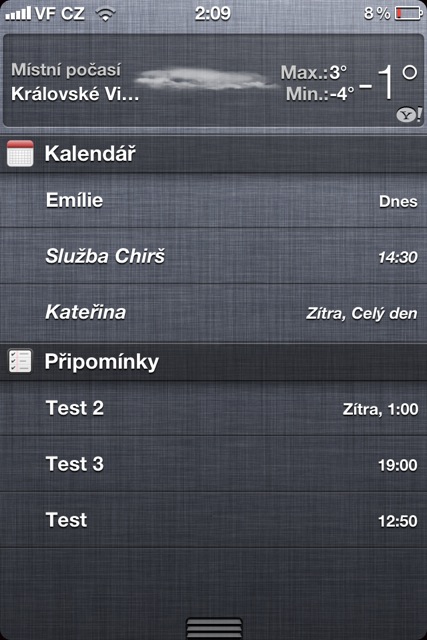
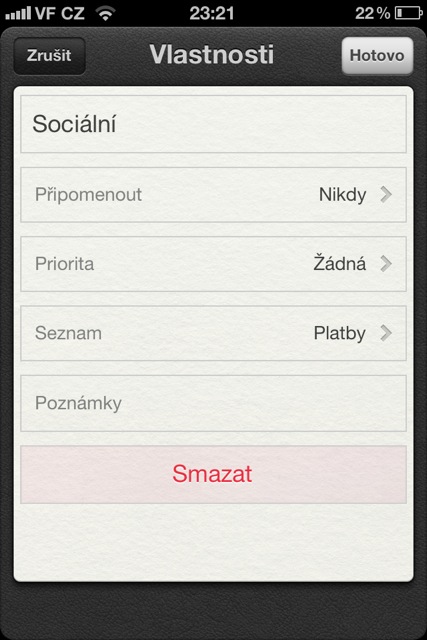
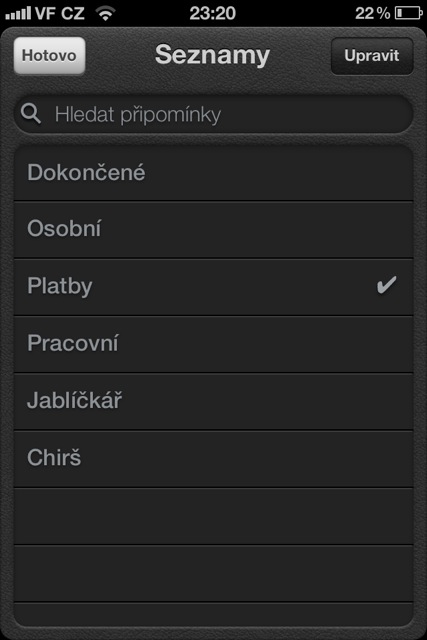

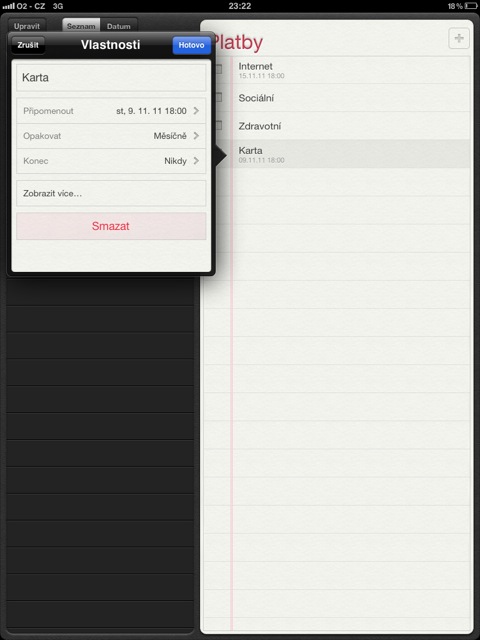
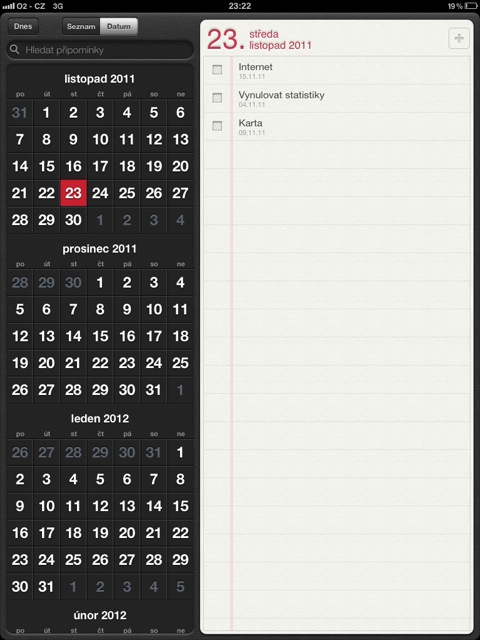
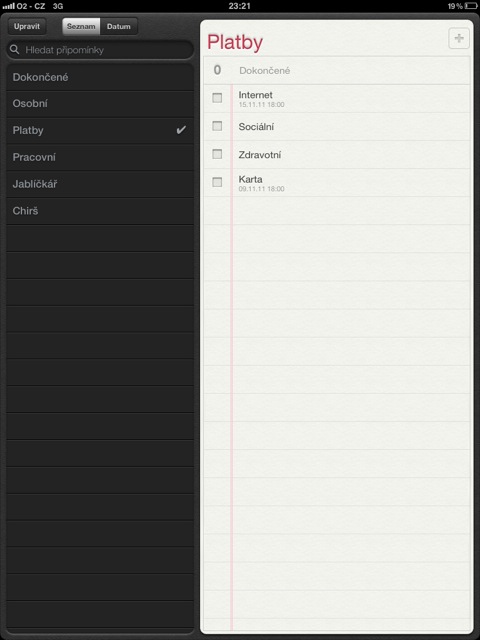
"The good news is that there is an API for this type of reminder in the SDK, so developers can integrate it into their apps, which OmniFocus developers have already done."
This is of course not true. Don't believe everything OmniGroup says :)
I use OmniFocus and it has been integrated there for at least a week, maybe longer. So of course I would be cautious in my claims.
The iOS SDK does not contain any API for working with reminders, neither for writing nor for reading. OmniFocus used a custom solution to the problem (including the limitation that comes with it) and marketing presents it as an implementation of the Reminders API. Personally, I'm surprised that Apple tolerates them.
Look, I don't know if I have another version (I doubt it) or I'm just blind, but there is no offer to remind me by location. When I enter a reminder according to the instructions, then I click on it, it shows REMINDER and there is only the DAY item, but there is nothing according to the location. Then, of course, there is also a selection of PRIORITY and REPEAT, then NOTES. But to remind me of the place, it's simply not there at all. I have an iPhone 3GS, no JB and iOS 5.0.1.
I don't know where I'm doing wrong, but even Google didn't help...
This feature is not available on the 3GS.
Oh, thanks... I thought I was the only one lucky enough to get another bug
3GS does not have location by location….
The iPhone version is great, and despite the missing badge with the number of uncompleted current tasks and the impossibility of specifying a specific place for a reminder when I don't have an address assigned to a contact in the Address book, I find it perfectly usable. What bothers me is the lack of adequate applications/presentations in OS X, where I spend most of the day. Do you have any tips for to-do apps that work with iCal/Reminders todo sheets?
For example, the 2Do application.
Hello, I want to ask a question... I have an iPhone4 and when I type in a comment, it reminds me on the spot
and I have a filled-in address, e.g. for work, so I still don't get a reminder, but location services are turned on all the time, I don't understand... I tried addresses with and without diacritics, I also looked to see if location services were turned off, still nothing came... even though I entered when leaving the place and when arriving at the place... has anyone had a similar problem?
I have an iPhone 4S and I had this problem too, but suddenly it started working on its own... Maybe it was just that on some mils the iP was not receiving the GPS signal well, I don't know. On iOS 5.0 it sometimes did it, never on 5.0.1 - I only tried 2 times and the same place each time ;)
Reminders has one more great feature that was not mentioned in the article and that is sharing the list via iCloud with someone else, similar to how you can share calendars. It must be set via the web interface http://www.icloud.com. For example, my wife and I share a shopping list.
I think that even the iPad 2 3G does not have location reminders, or at least I did not find them
Does anyone know where to find fields for entering a deadline for individual tasks? I have them for the older tasks, but not for the new ones and can't find them. Only the possibility to remind and repeat. I have an iPad2.dik.